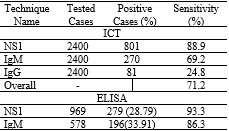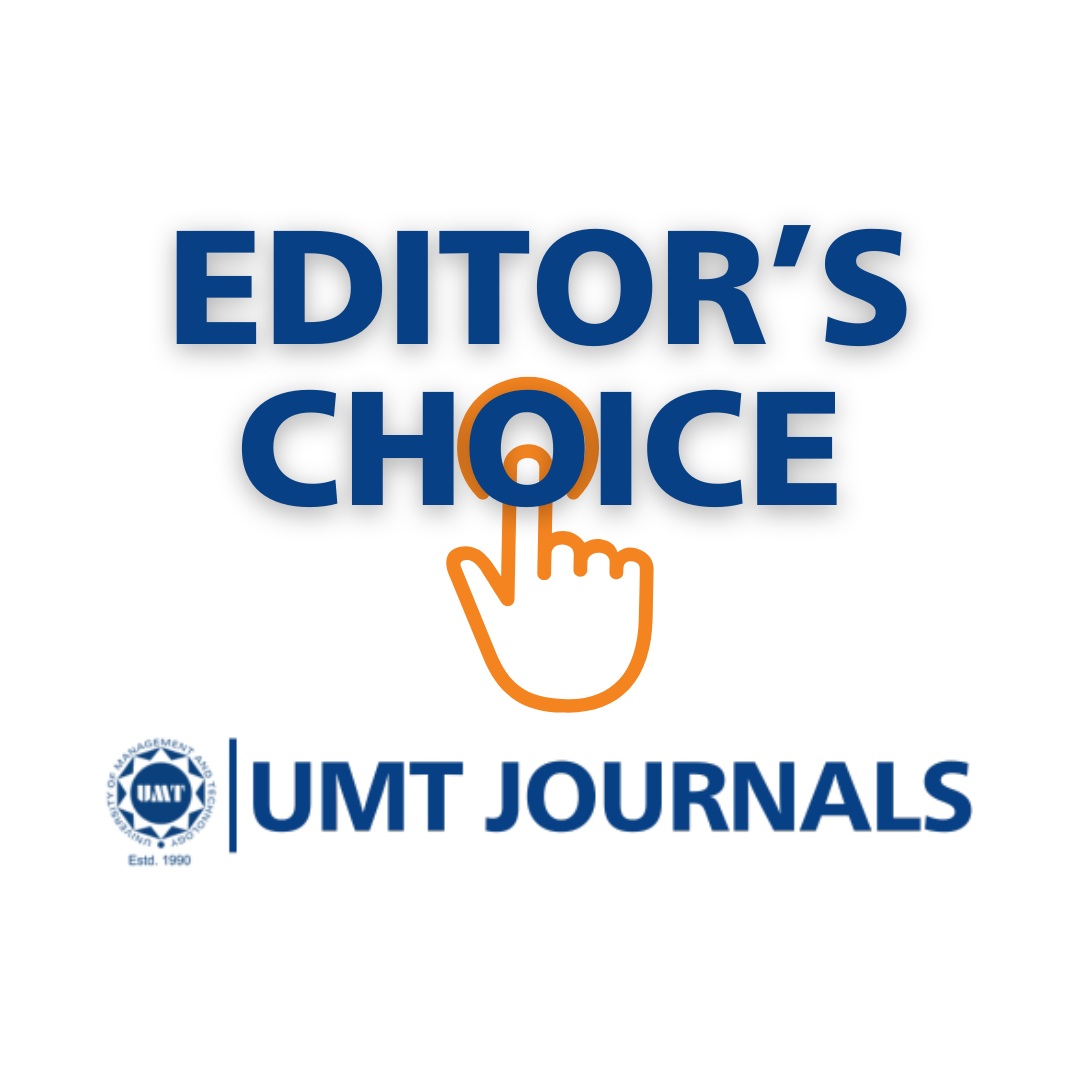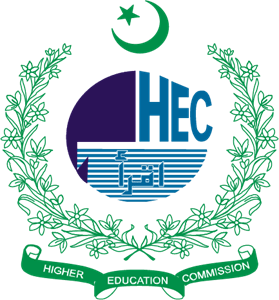Clinical Significance of Molecular and Blood Biomarkers in Assessing the Severity of Dengue Infection in Peshawar, Pakistan
Abstract
 Abstract Views: 0
Abstract Views: 0
Objective. The current study was aimed to evaluate the impact of molecular and blood biomarkers on the severity of dengue fever.
Method. This study was conducted at the Center for Microbiology and Biotechnology, University of Peshawar, Khyber Pakhtunkhwa, Pakistan from June 2022 to November 2022. A total of 2,400 individuals exhibiting prominent signs and symptoms of dengue fever were enrolled. These subjects were screened for the presence of NS1, IgG, and IgM antibodies, as well as molecular biomarkers, using PCR.
Results. Out of the 2,400 suspected cases, 801 (33.37%) were confirmed for dengue fever based on NS1 antigen (33.37%), as well as IgG (3.37%) and IgM (11.25%) antibodies, with RT-PCR demonstrating 98.2% sensitivity. The DENV-3 serotype was identified as the most prevalent (61.18%). The highest infection rate was observed in men (56.05%), as compared to women (43.95%). The most affected age group was 16-30 years (46.19%). Common symptoms among the patients included fever (100%), muscle pain (100%), headache (69.78%), vomiting (49.2%), and skin rash (35.08%). The study found a significant association (p < 0.05) between hematological parameters and dengue infection, highlighting a significant decrease in total leucocyte count (TLC), eosinophils, neutrophils, and platelets, as well as a significant increase in monocytes and lymphocytes. Additionally, mild cases exhibited fewer clinical signs as compared to severely infected cases.
Conclusion. Based on the current report, it was concluded that climate change, rapid urbanization, and the emergence of different serotypes may escalate dengue outbreaks in District Peshawar, KPK, Pakistan. This highlights the critical necessity for extensive insect-control operations, public education campaigns, and climate-responsive strategies to successfully prevent future dengue epidemics.
Downloads
References
Ali S, Salman M, Din M, Khan K, Ahmad M, Khan FH, Arif M. Dengue outbreaks in Khyber Pakhtunkhwa (KPK), Pakistan in 2017: an integrated disease surveillance and response system (IDSRS)-based report. Polish J Microbiol. 2019;68(1):115–119. https://doi.org/10.21307/pjm-2019-013
World Health Organization. Dengue and Severe Dengue (2024). WHO Web site https://www.who.int/news-room/fact-sheets/detail/dengue-and-severe-dengue. Accessed January 21, 2025.
Anwar F, Tayyab M, Salman M, et al. Dengue outbreak 2018 in district Shangla KPK; clinical features and laboratory markers of dengue virus infection. Future Virol. 2020;15(10):693–699. https://doi.org/10.2217/fvl-2019-0130
Boulaaras S, Jan R, Khan A, Ahsan M. Dynamical analysis of the transmission of dengue fever via Caputo-Fabrizio fractional derivative. Chaos Solitons Fractals: X. 2022;8:e100072. https://doi.org/10.1016/j.csfx.2022.100072
Morra ME, Altibi AM, Iqtadar S, et al. Definitions for warning signs and signs of severe dengue according to the WHO 2009 classification: systematic review of literature. Rev Med Virol. 2018;28(4):e1979. https://doi.org/10.1002/rmv.1979
Abdul-Ghani R, Mahdy MA, Al-Eryani SM, et al. Impact of population displacement and forced movements on the transmission and outbreaks of Aedes-borne viral diseases: Dengue as a model. Acta Tropica. 2019;197:e105066. https://doi.org/10.1016/j.actatropica.2019.105066
Haider Z, Ahmad FZ, Mahmood A, et al. Dengue fever in Pakistan: a paradigm shift; changing epidemiology and clinical patterns. Perspect Public Health. 2015;135(6):294–298. https://doi.org/10.1177/1757913915599019
Rai MA. Control of dengue fever in Pakistan. Nature. 2011;479:e41. https://doi.org/10.1038/479041d
Rasheed SB, Butlin RK, Boots M. A review of dengue as an emerging disease in Pakistan. Pub Health. 2013;127(1):11–17. https://doi.org/10.1016/j.puhe.2012.09.006
Khan J, Khan I, Amin I. A comprehensive entomological, serological and molecular study of 2013 dengue outbreak of Swat, Khyber Pakhtunkhwa, Pakistan. PloS One. 2016;11(2):e0147416. https://doi.org/10.1371/journal.pone.0147416
Khan J, Khan A. Incidence of dengue in 2013: dengue outbreak in District Swat, Khyber Pakhtunkhwa, Pakistan. Inter J of Fauna and Biolo Stud. 2015;2(1):1–7.
World Health Organization. Dengue-Pakistan (2022). WHO Web site. https://www.who.int/emergencies/disease-outbreak-news/item/2022-DON414. Accessed November 1, 2023.
World Health Organization. Dengue fever – Pakistan. WHO Web site. https://www.who.int/emergencies/disease-outbreak-news/item/dengue-fever-pakistan. Updated October 11, 2024.
Paranavitane SA, Gomes L, Kamaladasa A, et al. Dengue NS1 antigen as a marker of severe clinical disease. BMC Infect Dis. 2014;14(1):1–7. https://doi.org/10.1186/s12879-014-0570-8
Urooj H, Altaf S, Saadat E, Qadir MS, Moiz B. Characterization of thrombocytopenia in pediatric patients in noncritical hospital setting: an institutional review from Pakistan. J Pediat Hematol/Oncol. 2025;47(1):1–6. https://doi.org/10.1097/MPH.0000000000002972
Kashif M, Afzal M, Zeshan B, Javed H, Batool S, Mazhar M. Molecular and haematological analysis of dengue virus-3 among children in Lahore, Pakistan. Jundishapur J Microbiol. 2021;14(1):e109512. https://doi.org/10.5812/jjm.109512
Rehman AU, Anwar F, Tayyab M, et al. Incidence of Dengue fever, serotypes, clinical features, and laboratory markers: a case study of 2019 outbreak at district Shangla, KP, Pakistan. Afr Health Sci. 2022;22(1):521–531. https://doi.org/10.4314/ahs.v22i1.61
Kulkarni RD, Patil SS, Ajantha GS, et al. Association of platelet count and serological markers of dengue infection-importance of NS1 antigen. Indian J Med Microbiol. 2011;29(4):359–362. https://doi.org/10.4103/0255-0857.90159
Pal S, Dauner AL, Mitra I, et al. Evaluation of dengue NS1 antigen rapid tests and ELISA kits using clinical samples. PLOS ONE. 2014;9(11):e113411. https://doi.org/10.1371/journal.pone.0113411
Khan J. Pakistan reports 2,795 dengue cases in last seven days. ARY Web site. https://arynews.tv/pakistan-reports-2795-dengue-cases-in-last-seven-days/. Accessed January 21, 2025.
Hakim R, Bibi S, Ali Q, et al. Molecular epidemiology of dengue virus circulating during 2021 outbreak in Pakistan. Future Virol. 2023;18(9):545–555. https://doi.org/10.2217/fvl-2022-0196
Wahala WM, Kraus AA, Haymore LB, Accavitti-Loper MA, de Silva AM. Dengue virus neutralization by human immune sera: role of envelope protein domain III-reactive antibody. Virology. 2009;392(1):103–113. https://doi.org/10.1016/j.virol.2009.06.037
Saud B, Adhikari S, Maharjan L, Paudel G, Amatya N, Amatya S. An epidemiological prospective of focal outbreak of dengue infection in Kathmandu, Nepal. J Clinic Virol Plus. 2022;2(1):e100063. https://doi.org/10.1016/j.jcvp.2022.100063
Farrukh AM, Ganipineni VD, Jindal U, et al. Prevalence and outcomes of Myocarditis in dengue viral fever: A systematic review and Meta-analysis. Curr Prob Cardiol. 2023:e102029. https://doi.org/10.1016/j.cpcardiol.2023.102029
Haider Z, Ahmad FZ, Mahmood A, et al. Dengue fever in Pakistan: a paradigm shift; changing epidemiology and clinical patterns. Perspect Public Health. 2015;135(6):294–298. https://doi.org/10.1177/1757913915599019
Shams N, Amjad S, Yousaf N, Ahmed W, Seetani NK, Farhat S. Dengue knowledge in indoor dengue patients from low socioeconomic class; etiology, symptoms, mode of transmission and prevention. J Ayub Med College Abbott. 2018;30(1):40–44.
Shahid M, Amin I, Afzal S, et al. Prevalence and molecular detection of dengue virus in 2013 outbreak in KPK and Punjab, Pakistan. Pak J Zool. 2017;49(3):1119–1122. https://doi.org/10.17582/journal.pjz/2017.49.3.sc4
Abdullah, Ali S, Salman M, Khan M. A looming twindemic of COVID-19 and dengue on post-flood scenario in the developing countries. Asian Pacific J Trop Med. 2022;15(9):383-384. https://doi.org/10.4103/1995-7645.356990
Khan J, Ghaffar A, Khan SA. The changing epidemiological pattern of Dengue in Swat, Khyber Pakhtunkhwa. PLOS ONE. 2018;13(4):e0195706. https://doi.org/10.1371/journal.pone.0195706
Ahmed S, Arif F, Yahya Y, et al. Dengue fever outbreak in Karachi 2006--a study of profile and outcome of children under 15 years of age. J Pak Med Assoc. 2008;58(1):4–8.
Suleman M, Faryal R, Alam MM, et al. Dengue virus serotypes circulating in Khyber Pakhtunkhwa province, Pakistan, 2013-2015. Ann Labor Med. 2017;37(2):e151. https://doi.org/10.3343/alm.2017.37.2.151
Srikiatkhachorn A, Gibbons RV, Green S, et al. Dengue hemorrhagic fever: the sensitivity and specificity of the world health organization definition for identification of severe cases of dengue in Thailand, 1994–2005. Clinic Infect Dis. 2010;50(8):1135-43. https://doi.org/10.1086/651268
Anwar F, Ullah S, Aziz AU, et al. Epidemiological and hematological investigation of dengue virus infection. Microbiol Immunol. 2022;66(9):426–432. https://doi.org/10.1111/1348-0421.13018

Copyright (c) 2025 Aiman Waheed, Muhammad Adnan, Faisal Khan, Asif Ali, Nadia Kauser, Muhammad Moiz Malik

This work is licensed under a Creative Commons Attribution 4.0 International License.
BSR follows an open-access publishing policy and full text of all published articles is available free, immediately upon publication of an issue. The journal’s contents are published and distributed under the terms of the Creative Commons Attribution 4.0 International (CC-BY 4.0) license. Thus, the work submitted to the journal implies that it is original, unpublished work of the authors (neither published previously nor accepted/under consideration for publication elsewhere). On acceptance of a manuscript for publication, a corresponding author on the behalf of all co-authors of the manuscript will sign and submit a completed the Copyright and Author Consent Form.









